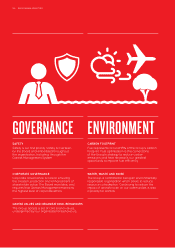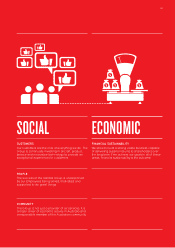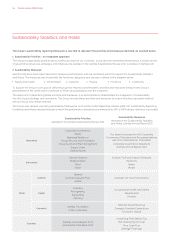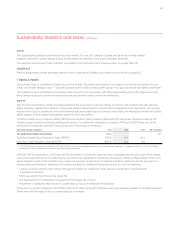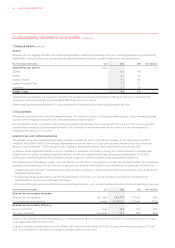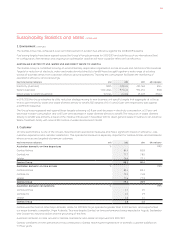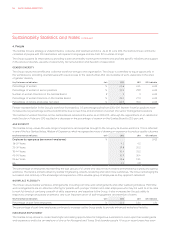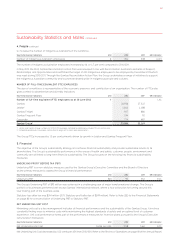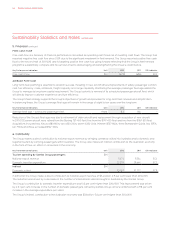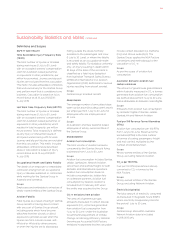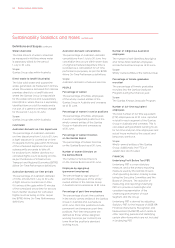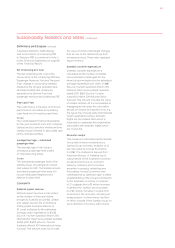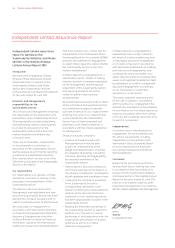Qantas 2012 Annual Report Download - page 151
Download and view the complete annual report
Please find page 151 of the 2012 Qantas annual report below. You can navigate through the pages in the report by either clicking on the pages listed below, or by using the keyword search tool below to find specific information within the annual report.
Sustainability Statistics and Notes continued
SAFETY AND HEALTH
Total Recordable Injury Frequency Rate
(TRIFR)
The total number of injuries or illnesses
during work hours (1 July to 30 June)
with an accepted workers’ compensation
claim for Australian based personnel,
or equivalent in other jurisdictions, per
million hours worked. Journey and slip port
injuries are excluded from this calculation.
This metric includes embedded contractors
that work exclusively for the Qantas Group
and perform work that is considered core
business. Calculation is based on injury
record status as at 13 July 2012 (2011:
14 July 2011).
Lost Work Case Frequency Rate (LWCFR)
The total number of injuries or illnesses
during work hours (1 July to 30 June)
with an accepted workers’ compensation
claim for Australian based personnel, or
equivalent in other jurisdictions, which
resulted in total incapacity, per million
hours worked. Total incapacity is defined
as any injury or illness that results in
an injured worker being unfit for work.
Journey and slip port injuries are excluded
from this calculation. This metric includes
embedded contractors (as described
above). Calculation is based on injury
record status as at 13 July 2012 (2011:
14 July 2011).
Occupational Health and Safety Fatality
The death of an employee or embedded
contractor arising from an occupational
injury or disease sustained or contracted
while working for the Qantas Group in
Australia and overseas.
Scope:
Employees and embedded contractors of
wholly-owned entities of the Qantas Group.
Aviation Fatality
Fatal injuries as a result of being in Qantas
Group aircraft or having direct contact
with any part of Qantas Group aircraft,
including parts which have become
detached from the aircraft, or direct
exposure to jet blast except when the
injuries are from natural causes, self-
inflicted or inflicted by other persons,
or when the injuries are to stowaways
hiding outside the areas normally
available to the passengers and crew
(1 July to 30 June), or where the fatality
is recorded as an occupational health
and safety fatality. For statistical uniformity
only, an injury resulting in death within
30 days of the date of the accident is
classified as a fatal injury (adapted
from Australian Transport Safety Bureau
(ATSB) and International Civil Aviation
Organization (ICAO) definitions for serious
injuries resulting from aircraft events).
Scope:
Qantas Group branded aircraft.
Absenteeism
The average number of annualised days
taken as sick leave (including carer’s leave)
per employee from 1 July to 30 June for
employees who are employed as at
30 June.
Scope:
All Australian and New Zealand based
employees of wholly-owned entities of
the Qantas Group.
ENVIRONMENT
Aviation fuel consumption
The total volume of aviation kerosene
consumed by the Qantas Group’s flying
businesses from 1 July to 30 June.
Scope:
Aviation fuel consumption includes Qantas,
Jetstar, QantasLink, Network Aviation,
Jetconnect and Qantas Freight, for both
domestic and international operations.
Aviation fuel consumption does not
include consumption by Jetstar Asia
or codeshare partners. Aviation fuel
consumption by Network Aviation is
included from 11 February 2011 when
this entity was acquired by the Group.
CO2-e emissions from aviation
The amount of greenhouse gas
emissions measured in carbon dioxide
equivalent (CO2-e) tonnes generated
from aviation fuel consumption from
1 July to 30 June. Under the Australian
Government’s Department of Climate
Change and Energy Efficiency National
Greenhouse Accounts (NGA) Factors,
emissions incorporated into the calculation
include carbon dioxide (CO2), methane
(CH4) and nitrous oxide (N2O). The
Qantas Group applies the NGA Factors
conversions and methodology for the
calculation of CO2-e.
Scope:
As per the scope of aviation fuel
consumption.
Australian domestic aviation fuel
carbon emissions
The amount of greenhouse gas emissions
within Australia measured in CO2-e tonnes
generated from aviation fuel consumption
(as defined above) from 1 July to 30 June
that is attributable to domestic coded flights.
Scope:
Emissions from aviation fuel consumption
by domestic flights of Qantas, Jetstar,
QantasLink and Network Aviation.
Fuel per 100 Revenue Tonne Kilometres
(RTKs)
Aviation fuel consumption per 100 RTKs
from 1 July to 30 June. Revenue tonne
kilometres (RTKs) is the total number
of tonnes of paying passengers, freight
and mail carried, multiplied by the
number of kilometres flown.
Scope:
Wholly-owned entities of the Qantas
Group, excluding Network Aviation.
CO2-e per 100 RTKs
Fuel per 100 RTKs (as defined above)
converted to CO2-e tonnes by the
NGA Factors.
Scope:
Wholly-owned entities of the Qantas
Group, excluding Network Aviation.
Electricity (Australia)
The total amount of electricity consumed
as measured in megawatt hours (MWh)
where electricity is separately billed for
the period 1 July to 30 June.
Scope:
Qantas Group sites within Australia.
Network Aviation data is included
in 2011/2012 only.
Definitions and Scopes
149



